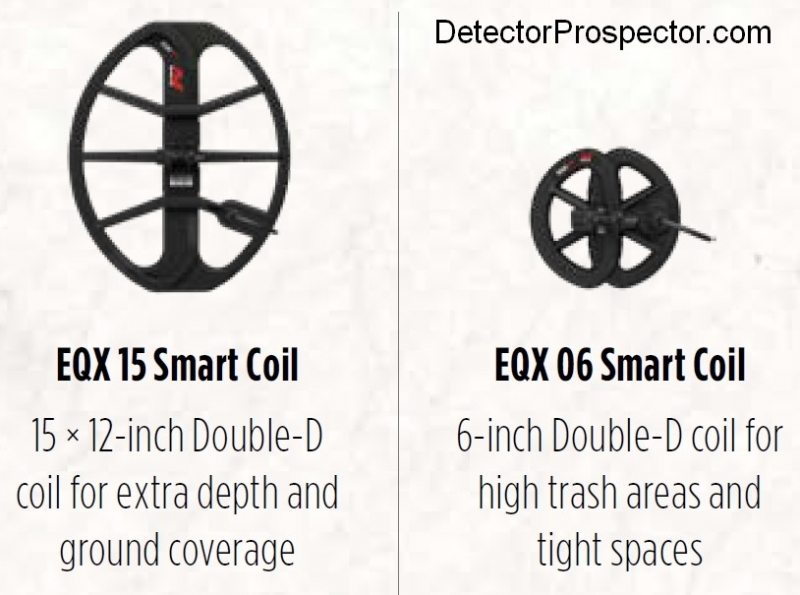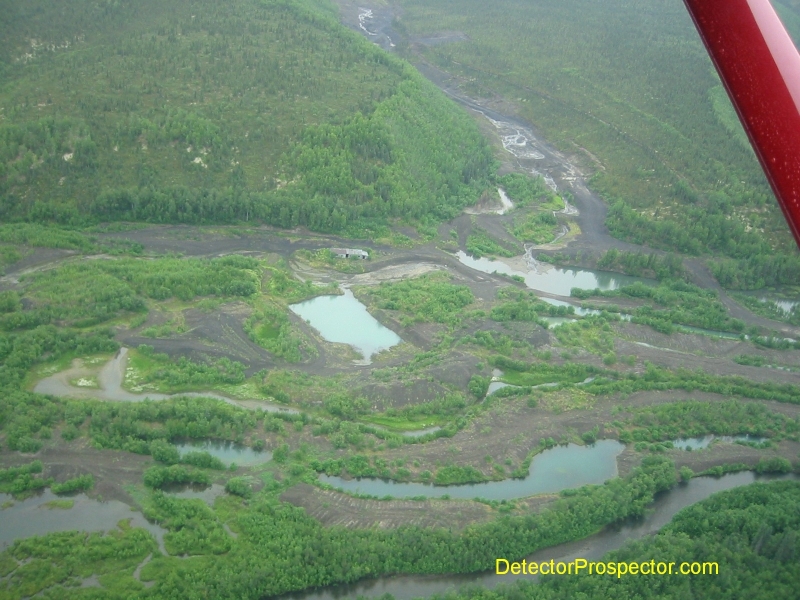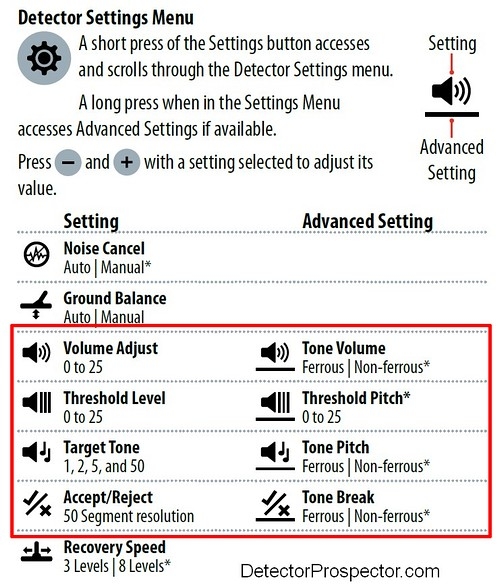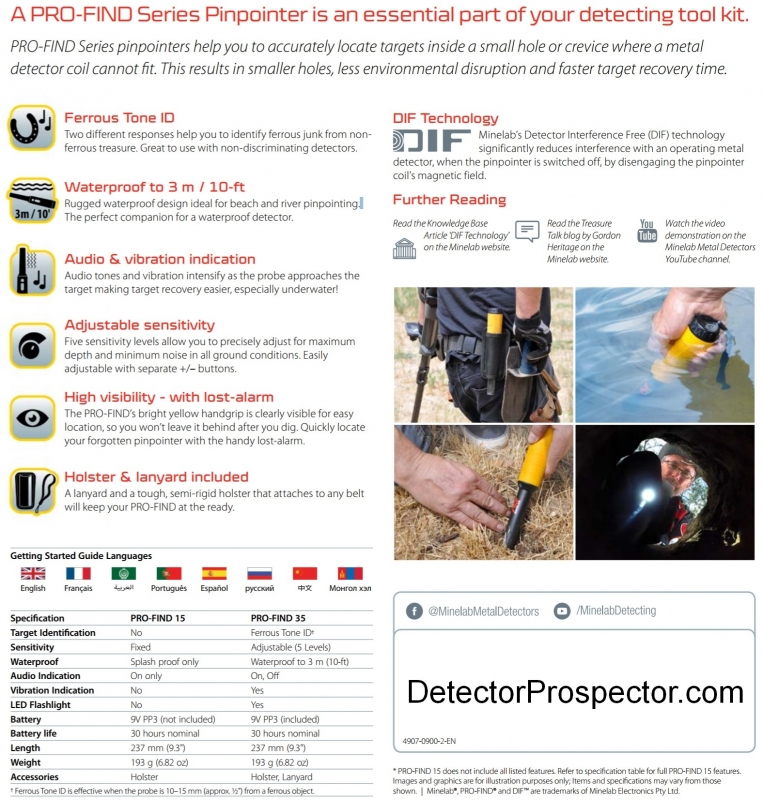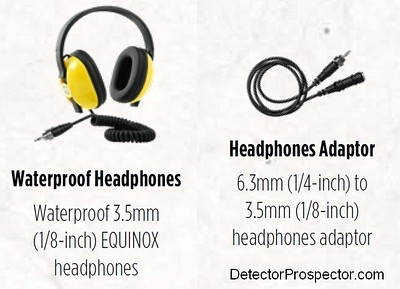-
Posts
19,759 -
Joined
Content Type
Forums
Detector Prospector Home
Detector Database
Downloads
Everything posted by Steve Herschbach
-
This is real... from http://www.detectorprospector.com/metal-detecting/minelab-multi-iq-technology-details-explained.htm I have highlighted what I think you should really pay attention to. Multi-IQ is derived from: Simultaneous Multi-Frequency In-phase and Quadrature Synchronous Demodulation. We can go to a statement from Dr Philip Wahrlich, our principal technology physicist, about a key difference of Multi-IQ compared to the demodulation taking place in conventional single frequency VLF detectors: “Within the Multi-IQ engine, the receiver is both phase-locked and amplitude-normalized to the transmitted magnetic field – rather than the electrical voltage driving the transmitted field. This field can be altered by the mineralization in the soil (in both phase and amplitude), so if the receiver was only phased-locked to the driving voltage, this would result in inaccurate target IDs and a higher audible noise level. Locking the receiver to the actual transmitted field, across all frequencies simultaneously (by measuring the current through the coil) solves these issues, creating a very sensitive AND stable detector” Precisely measuring these extremely small current variations is quite remarkable if you consider the levels involved. It’s actually parts per billion, or nanoamp signals, we are talking about here! With Multi-IQ, we can derive much greater target ID accuracy and increased detecting performance, especially in ‘difficult’ ground. In ‘mild’ ground, single frequency may perform adequately, BUT depth and stable ID’s will be limited by ground noise; whereas the Multi-IQ simultaneous multi-frequency will achieve maximum depth with a very stable target signal. In ‘strong’ ground, single frequency will not be able to effectively separate the target signal, giving decreased results; whereas Multi-IQ will still detect at depth, losing a minimal amount of target accuracy. Let’s hear more from Philip Wahrlich about the technical details: “For each frequency the detector transmits and receives there are two signals which can be extracted which we refer to as I and Q. The Q signal is most sensitive to targets, while the I signal is most sensitive to iron content. Traditional single-frequency metal detectors use the Q signal to detect targets, and then use the ratio of the I and Q signals to assess the characteristics of the target and assign a target ID. The problem with this approach is that the I signal is sensitive to the iron content of the soil. The target ID is always perturbed by the response from the soil, and as the signal from the target gets weaker, this perturbation becomes substantial. With some simplification here for brevity, if a detector transmits and receives on more than one frequency, it can ignore the soil sensitive I signals, and instead look at the multiple Q signals it receives in order to determine a target ID. That way, even for weak targets or highly mineralized soils, the target ID is far less perturbed by the response from the soil. This leads to very precise target IDs, both in mineralized soils and for targets at depth.” I can sum this up simply by saying Equinox correctly identifies non-ferrous items that previous detectors mis-identified in some way. In bad ground non-ferrous items often are incorrectly identified as ferrous. The depth at which this happens may be much shallower than people think. I can promise anyone that uses an Equinox for very long will start making good finds at depths that are shallow enough you would swear there is no way they could have been missed by so many detector for so long. But as Tom Dankowski is fond of saying, you can’t know what you are missing. Well, Equinox lets you know about at least some of what we have been missing. The depth is there also, but there is more going on here than just “more depth”.
-

Minelab, Please Tell Us What The Coils Cost!
Steve Herschbach replied to Ridge Runner's topic in Minelab Equinox Forum
Minelab EQX 15 DD Search Coil, 15×12 inches (38×30 cm) Minelab EQX 06 DD Search Coil, 6 inches (15 cm) Both coils are supplied with a removable scuff cover / skid plate. It would be nice to know what the most important accessories you can buy for the Equinox will cost. I would hope for X-Terra type coil prices (coils usually under $200) rather than CTX type prices (coils are over $200). I just can’t see people buying a $649 detector reacting well to high price coils. Let’s not stop there however - what do all the accessory items sell for? Inquiring minds want to know! -
Minelab would be wise not to impede aftermarket coils in any way. Actively helping and encouraging them would be best. As Ringmoney illustrates coil selection is a very important factor with any new detector, and expanding the selection as rapidly as possible can do nothing but help Minelab sell more Equinox detectors.
-
Nuggets like that are perfect! I honestly would rather have 10 ounces of those than a 10 ounce nugget - great find!
-
I have been dealing with my own "wall" at about 6" due the the heavy magnetite content of the ground here. Nothing except a PI seemed to get me past it. I do know exactly what you are talking about. Since I got the EQX800 I am for the first time in ages finding silver on almost every outing, sometimes multiples. (Show and tell down the road one of these days). That has not happened to me in a long time. So yes, I do feel there is an edge but it is not strictly due to outright depth but the combination of a new multifrequency method and high speed. The problem, and people are going to hear this a lot, is that the world is a big place and I only have access to a tiny bit of it. I can't and will not make any blanket statements or promises regarding how the Equinox everywhere because I just do not know. The last thing I want you doing is getting one because I said it will give you that extra inch in Alabama only to find out it does not. In my own way I am out on a limb because more than most people I realize the vast disparity of hunting conditions we all face and I am not so arrogant as to think I can know better than the people actually on site. This is all complicated by the fact that Multi-IQ really is new, and so I can't project anything I have learned from other detectors over the years onto it. It really is a new ballgame. It is a bit frustrating however as I do currently have what appears to be a secret weapon as regards local "hunted out" parks, but I am facing imminent winter and a week long trip to Alaska soon that puts a hole in what tiny amount of time I have left, unless I get real lucky and the weather stays mild. Even that won't stop me but the drives will get longer. Long story short I would like to put this thing over every bit of dirt within 100 miles before anyone else gets one but right now I am fighting just to get a few hours here and a few hours there. The best way to do these things is treat me as a single data point. You can trust what I say but at the same time everything has to be taken with a grain of salt. The other testers should get more active soon, and you can add their data points. Sooner or later regular folks will start adding their own information. Right now you have a fuzzy picture but it will just keep getting sharper. All the machines you all have are still working and this is not an emergency. It is just a matter of following along until you are comfortable about pulling the trigger - or not
-

My Equinox " Coming Out " Statement
Steve Herschbach replied to Steve Herschbach's topic in Minelab Equinox Forum
Hi Brian, You and Tom are awesome. He especially being my gold coin hero - I have yet to find one and he has dozens? Amazing! I have been detecting since 1972 and basically hunt precious metals - gold, silver, platinum - in any form they come in. Coins, jewelry, nuggets. My relic detecting has therefore been more accidental, stuff found while looking for gold nuggets or old coins. My detecting is usually “dig everything” or “dig all non-ferrous”. So yeah I have done the dense trash stuff but not as much as you guys. I think you guys will be happy with what develops, and for once nobody need take out a mortgage to find out! It has been said many times that the CTX and Deus are an excellent complimentary pair, each one strongest where the other is weakest. Well, this burly Australian snuck into the XP camp and had his way with a cute little French gal. The Equinox is like the kid they had who has all the best features of both. Nothing is perfect but there truly is nothing else like Multi-IQ, and in my opinion by just being different (think FAST multifrequency) it does things other machines do not do. Some of the finds I am making are real head shakers but that will have to wait a bit. I guess the good news is the Equinox has finally got me seriously interested in coin detecting again. It’s nice to find silver almost every time I head out to the parks for a few hours. It’s been a long time since a detector did that for me. My best coin and relic hunt ever -

My Equinox " Coming Out " Statement
Steve Herschbach replied to Steve Herschbach's topic in Minelab Equinox Forum
As well as any VLF can do out there competing with roving bands of GPZ 7000 owners! Rye Patch is actually fairly mild ground and not much of a challenge for a VLF so the Equinox will have no problems there. The hard part is simply getting over a nugget. -
From the Teknetics Facebook page... Some more information on the T2+. What we know so far: - The T2+ has BOOST MODE - Waterproof 11-inch Open Frame Bi-Axial™ Searchcoil - Operating Frequency 13 kHz - Double Filter Discrimination Modes For Searching In Trashy Areas - Trigger Actuated FASTGRAB™ Instant Ground Canceling with manual override -The T2+ has a transferable warranty We're also throwing in a Digger with every T2+ https://www.tekneticsdirect.com/accessories/digger Digger Features - Tough carbon steel blade 7.5" L x 2" W - Total tool length 12" - Double-edged blade with 32 sharp cutting teeth to rip through - roots and dirt - No-slip blade guard - Comfortable rubber handle - Tough Cordura carry sheath for belt mount use
-

My Equinox " Coming Out " Statement
Steve Herschbach replied to Steve Herschbach's topic in Minelab Equinox Forum
Thanks Tim - that was kind of you! The only inane questions are the ones that don't get asked. I love answering questions and explaining stuff - should have been a teacher I guess. Discussing detecting and helping people makes me happy, so thanks in more ways than one! -
Yup, I agree an 8" would be great and many others agree also. Believe me, I always lobby hard for coils but you have to start somewhere. Three coils at launch is just a start. If Equinox is as popular as I think it will be there will be an entire cottage industry spring up making accessory items for it, including coils. If that's an issue just stick with what you have until the coil you want appears on the scene. Besides, you have Minelab's ear. I keep telling people these forums are closely watched and it matters what you say and how you present yourself. The Equinox did not pop out of thin air.
-

My Equinox " Coming Out " Statement
Steve Herschbach replied to Steve Herschbach's topic in Minelab Equinox Forum
I was never an "expert" with the CTX and so I am not in a position to comment on that because I am not familiar with the trick you are referring to and how well it works. All I can tell you is the volume and tone adjustments on the Equinox are covered pretty well on the other thread. And for that matter I still have things to learn about the Equinox. I have been very carefully avoiding that question, and this post was my official "letting the cat out of the bag". Yes, I have been involved with Minelab on Equinox development and quite proud of it. Unfortunately I can't say a single other thing about that other than to confirm it! It is all about what happens from here on out that matters. -

Detecting Dredge Piles Question?
Steve Herschbach replied to oneguy's topic in Detector Prospector Forum
It seems I have spent half my life detecting tailing piles - there are many stories at my Steve's Mining Journal on the subject. Ganes Creek and Moore Creek in particular. I have chased targets in cobbles like you describe for too many hours - but they can be gold. As a rough generality over the year I have found two hot spots in unhunted tailing piles (good luck finding those now). The very top of the pile came off the bottom of the workings and I have found some nice nugget mini-patches on the top of some tailing piles. The other spot is the lowest areas around tailing piles. Once nuggets start rolling they usually keep rolling all the way to the bottom. And then yes, you can find a nugget also just about anywhere else so nothing is off limits. Dragline operations in particular can be a real mess. Do keep an eye out for clay lumps, often covered with moss. If the gold is on a clay bottom a lot of gold gets caught up with clay chucks and discarded. Detect any areas with clay in the tailings very carefully. Another clue is ripped shards of bedrock on tops of tailing piles letting you know they really were at the bottom. Do check the records also. In Alaska many bucket line dredges worked areas where there was nothing but fine gold. I do not hunt tailing piles unless I have some sort of evidence nuggets were recovered in the area. Even then the patience and effort required can be daunting, but at least you know the chance of big gold really does exist, making it worth the effort. Aerial view of tiny portion of Ganes Creek tailings in 2002. The old machine shop shown in the photo was unfortunately destroyed in floods a few years ago. -
Just a reminder. Minelab USA offers a 15% discount on any Minelab metal detector from the MAP (minimum advertised price) to U.S. active or honorably discharged members of the military. Proof of past or active service is required and must be verified by providing a copy of a DD 214 or Military ID to qualify. The discount applies only to a metal detector purchase - parts and accessories do not qualify. This discount is not available in conjunction with other special promotions or individual dealer concessions. With discount the $899 Equinox 800 is only $764.15. The Minelab GPZ 7000, normally $7999, ends up being $6799.15, a savings of $1199.85
-
This topic split from a previous thread. Hi Brian, nice to see you back. I follow a lot of your posts elsewhere - great stuff! The reality is I have been and am part of the Equinox development team in my own small way. I therefore have access to information and knowledge that few do. Yes, I do have an Equinox 800. I have to tread carefully but my goal is to bury you guys with Equinox info to the best of my ability. I have a pretty good idea of what I can and can’t say yet, and I am sure Minelab will pull me quickly within bounds if I stray. That is one reason why I only post on this forum now - the original content must remain under my control. Please do not copy and paste elsewhere! Other testers to watch... There is Brandon Neice, who appeared in the Detectival announcement videos, and who is based in Idaho. Brandon goes by Dr. Tones on YouTube There are Derek & Sharon McLennan plus Neil Jones of the DUG THAT OFFICIAL MINELAB EQUINOX 800-600 GROUP who are based in the U.K. At Minelabowners.com, the gentleman posting as ironhearted_gog is Gordon Heritage, one of the members of the U.K. Equinox Test Team.
-
It only works if you are selling machines at the same time There are differences between the Equinox 600 and Equinox 800 but in my opinion the 600 really is the bang for the buck powerhouse. I do like all the extra tone options on the 800 but the reality for me is I normally hunt full tones (50 Tone mode). This is identical on both models. The vast majority of normal users do not need the Gold Mode (those that do know who they are). For $649 there is just nothing else on the market that comes close to the Equinox 600. Minelab could have priced it at $749 and the EQX800 at $999 and both would still sell like hot cakes. The extra low pricing is tossing gas on an already hot fire!
-
I sold the XP Deus, Nokta Impact, Teknetics G2, Minelab CTX 3030, Fisher Gold Bug 2, and one of my Garrett ATXs is currently up for sale. They are being replaced with the Equinox 800 freeing up a lot of space and putting a good chunk of change back in my pocket. I do think the Equinox 600 is more than sufficient for most people. Honestly, it would do me quite well. Seeing all the machines I have eliminated and cash freed up however, the Equinox 800 for just $250 more is an easy “why not”?
-

Fisher F75+ Announced
Steve Herschbach replied to Steve Herschbach's topic in First Texas - Bounty Hunter, Fisher & Teknetics
From the Fisher Facebook page: Some more information on the F75+. What we know so far: - The F75+ has BOOST and CACHE MODE - Waterproof 11-inch Open Frame Bi-Axial™ Searchcoil - Operating Frequency 13 kHz - Double Filter Discrimination Modes For Searching In Trashy Areas - Trigger Actuated FASTGRAB™ Instant Ground Canceling with manual override -The F75+ has a transferable warranty What you don't know: We're also throwing in a Digger with every F75+ Digger Features - Tough carbon steel blade 7.5" L x 2" W - Total tool length 12" - Double-edged blade with 32 sharp cutting teeth to rip through - roots and dirt - No-slip blade guard - Comfortable rubber handle - Tough Cordura carry sheath for belt mount use More to come soon... With Boost and now Cache Mode this is sounding more and more like a F75 Ltd. -

Minelab Equinox Tones & Advanced Tone Options
Steve Herschbach replied to Steve Herschbach's topic in Minelab Equinox Forum
I don't know. Lower price detectors far, far outsell top end models. It only seems otherwise because on the forums everyone talks about top end detectors. Considering what a new detectorist could get previously for $649 the Equinox 600 is like an automatic upgrade to a top tier model without the top tier price. But yeah, baby, 800 all the way for this kid! For most forum denizens used to paying over a grand for a flagship detector $899 sure will not be a problem. The Equinox actually exceeds the CTX on tone options in one way. There are four non-ferrous tones on the CTX can be moved around, but the ferrous tone can't be split in combined mode. Many people have requested the ability to split the ferrous into two zones. That can be done easily on the Equinox 800 by going to Five Tone mode. Assign two segments to the ferrous region as you wish, and distribute the remaining three non-ferrous segments. You would have only three tones non-ferrous but in return you would have the ferrous split into small ferrous and large ferrous. This is something relic hunters will appreciate. -
Yes, the waterproof headphones are optional since most people who buy an Equinox may never submerge it. I tend to assume myself they are the same Koss phones as used on other Minelab models (with the exception of the connector) but all that is just an assumption until we know for sure.
-
This information started out as part of a comparison between the Equinox 600 and Equinox 800 but I wanted to make it a subject of it's own by expanding on it here. The Equinox 600 and Equinox 800 are basically the same detector, but there are a few advanced options available on the Equinox 800 that are not available on the Equinox 600. This article explores the various tone options and what they are on each model. This image from the Minelab Equinox 600 / 800 Getting Started Guide highlights the audio setting options. The items marked with an asterisk denote features only available on the Equinox 800. Tone Volume - A relatively new feature allows some detectors to set the volume of the ferrous (iron and steel) tones to be lower than the volume of non-ferrous tone responses. This can be much easier on the ears in locations full of ferrous trash where every swing of the coil produces many ferrous responses, with the non-ferrous responses being few and far between. Both the Equinox 600 and 800 can adjust the ferrous tone volume. Relic hunters in particular find being able to adjust the ferrous tone volume to be a very useful function. Again, this feature is available on both Equinox models. The Equinox 800 goes a step farther in allowing the non-ferrous tone volumes to be adjusted. Maybe you have coins set to give a high tone, but you have a hearing loss in the high tone range. The Equinox 800 allows you to increase the volume of the high tone response in relation to the other tones, making it easier to hear. This is most useful in the five tone mode, which by default has one tone for ferrous, and four separate tones for different parts of the non-ferrous discrimination scale. Each of these four non-ferrous tones can have individual volume levels. Threshold Pitch - Both the Equinox 600 and 800 allow you to set the threshold volume level, but the Equinox 800 also allows you to set the threshold pitch or tone. Again, this is good for people that have hearing loss issues in particular ranges. Target Tone - Both Equinox models allow you to choose from several pre-set tone options. Single Tone (monotone), Two Tone (usually ferrous/non-ferrous), Five Tones, or Fifty Tones. The tones are preset but in conjunction with the Tone Volume above both the Equinox 600 and 800 let you adjust the ferrous volume to suit your ear. Tone Pitch - As noted before, both the Equinox models allow you to adjust the ferrous volume. Both models also allow you to customize the ferrous tone pitch. Maybe the tone is too high and you would like it to be lower. Or perhaps higher. Both Equinox models allow you to set both the ferrous volume and ferrous pitch or tone. The Equinox 800 also allows you to customize each non-ferrous pitch or tone to your preference. Again, good for those with hearing loss, but also very good for creating custom audio discrimination patterns. For example, perhaps the owner of an Equinox 800 is most interested in gold responses. The Five Tone mode has a very low tone for ferrous targets. The non-ferrous portion of the scale is divided up into four segments, with each segment making a higher pitch tone. Large silver coins are set by default to be the highest tone. This imaginary gold hunter might decide to set the high silver range as a low tone because very few gold items read in the high silver range. The operator could then more easily focus on the new mid-range higher tones as being more likely gold responses. Tone Break - The positions on the target id scale where one tone shifts to another is factory preset. Both the Equinox models let you adjust the point where ferrous tones shift to non-ferrous tones (the ferrous tone break) - a very important feature. Manufacturers try to set the zero point (or some other numeric reading) as being where ferrous tones shift to non-ferrous tone. The Equinox model discrimination scale is -9 through 0 as ferrous, and positive numbers 1 - 40 as non-ferrous Unfortunately, that point is actually an overlapping range, especially for small gold items and ferrous. The factory does the best they can, but certain soil conditions may cause non-ferrous items to read in the ferrous range. Both the Equinox 600 and Equinox 800 allow you to shift the ferrous break point up or down as you see fit. For instance, the operator may want to set -1 and -2 as non-ferrous readings. This means they will dig more ferrous items, but also possibly valuable non-ferrous items missed by others. With the Equinox 800 the other non-ferrous audio controls really come together knowing you can also adjust the break points between the non-ferrous tones. This means you can create totally custom audio discrimination modes on the Equinox 800. You can move the break points around as you please with the Equinox 800, and even use this to create four tone and three tone modes. Start with the five tone mode. You can move a couple target id segments to both read in the ferrous range and assign them a similar tone for instance, so two of the tones will be ferrous, and the three remaining tones assigned to non-ferrous items as the operator pleases. The Equinox 800 also allows for adjustments to the 50 Tone mode that are lacking in the Equinox 600, but the details of this feature are still being finalized. Tone volume, pitch, and break adjustments are an incredibly compelling feature for people like me that hunt almost entirely by ear with the target id numbers only coming into play after the fact. Still, more of an advanced user function for sure, which is why only the Equinox 800 has these options.
-

Got A Profind 35 This Weekend
Steve Herschbach replied to Buzzard's topic in Minelab Metal Detectors
I am sure everyone will be very interested to hear how the ferrous id function works out for you. More information on the Pro-Find pinpointers here -
There are dealers taking pre-orders or making lists, etc. Having been a dealer once this is risky business, as if (when) delays happen every customer is not happy. If I was a dealer taking pre-orders right now I would be warning my customers that a Christmas delivery is by no means promised. But people still won't be happy if they do not show up by then. With the current level of interest we are seeing, I would share your concern that it may be some time before anyone has an Equinox sitting on a shelf waiting to be purchased. More likely it will be catching up with backorders for awhile. Should not take them long to get up to speed however, as the Equinox design looks to me like it can be produced far more easily and quickly than machines like the CTX 3030.
-
Welcome to the forum! There are no waterproof headphones for the Equinox at this time because the detector is not on the market and available for sale. The first ones out will no doubt be the ones from Minelab that have the proper adapter on the end. There currently is no Equinox to CTX adapter (for the same reason as above) though perhaps somebody will produce one in the future. You are assuming the CTX headphones are the same specifications except for the adapter and we don't know that for sure yet, though the have a similar appearance. As far as why, only Minelab can answer for sure. However, my CTX could connect a waterproof headphone directly. Then, to use dry land phones, and large pass through "dummy module" has to be attached over the battery. This would be impossible to implement on the Equinox. The new connection allows for both waterproof and dry land headphones to be connected via a single, small fitting. Since keeping the weight down is important this is a solution that works. Perhaps there were other options but this is what we are getting. An adapter is included to attach standard 1/4" headphones but for other than underwater use I suspect most people will be going wireless.

